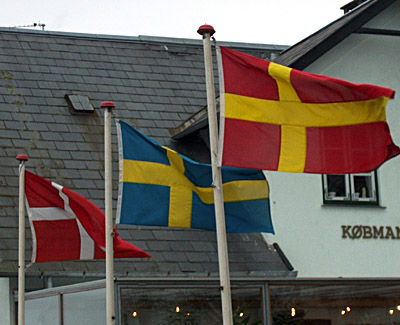| Integration

| | Udviklingen i transport- og kommunikationsmidler øger mobiliteten imellem Skåne og Sjælland væsentligt og det sydlige Sverige bliver nu også et yndet ferie- og fritidsmål for en voksende gruppe af hovedstadsdanskere. Fjernsynsmediet bringer en overgang befolkningerne tættere på hinanden, men den globale medieudvikling sætter også sine spor. |
Arbejdskraftens vandring
Arbejdskraftens vandring over sundet er en gammel historie. Siden middelalderen har folk bevæget sig derhen, hvor der var arbejde at finde og steder at slå sig ned. Selv i den periode, hvor det krævede pas for at krydse landegrænserne har fiskerbefolkningerne langs skysten opretholdt tæt kontakt og i løbet af 1800-tallet var emigrationen fra Sydsverige til Københavnsområdet ganske betydelig.
I industrialiseringens tidsalder var påvirkning og udveksling af ideer, arbejdskraft og iværksættelse på tværs af sundet af stor betydning og besættelsestidens tætte kontakter var af livsvigtig betydning for mange mennesker.
Efter 2.verdenskrig var Danmark præget af den stagnation, som krigstidsøkonomien uvægerligt medførte og flygtningestrømmen til Skåne blev i nogen grad afløst af arbejds- og indkøbshungrende danskere. Først i slutningen af 1950erne vender udviklingen i Danmark for alvor og konjunkturarbejdsløsheden afløses af strukturel betinget efterspørgsel efter f.eks. danske læger i en lang periode.
I midten af 1970erne vender konjunkturerne igen og arbejdsløsheden i Danmark stiger voldsomt, hvilket bl.a. kan aflæses af de omkring 17.000 danskere som vælger at søge over sundet for at finde arbejde og i en del tilfælde også bosætte sig.
Danmark gennemgår især i løbet af 1980erne en række strukturelle ændringer, hvor det gamle industrisamfund afvikles og velfærdssamfundet knager i sine fuger. Det ser ud til at det sydlige Sverige gennemgår samme proces med en vis forsinkelse og at medlemskabet af EU og satsningen på at styrke den regionale integration skal være midler til at genskabe dynamikken i Øresundsregionen.

Byggeplads i Helsingborg | 
H-H aksen set fra oven | 
Brovision | 
Saltholm, Peberholmen og broen |
Danske Torpare
Med den forøgede færge- og biltrafik i 1960erne opstod nye muligheder for at bevæge sig omkring i nabolandene og hermed åbnes også nye fritids- og feriemuligheder for storbymennesker i Københavnsområdet. Især da der åbnes op for at danskere kan erhverve fast fritidsejendom i Sydsverige.
Den anden industrialiseringsbølge som rammer begge sider af Øresund i tiden efter 2.verdenskrig har som et af sine kendetegn en fortsat tiltagende urbanisering, hvor landsbysamfundene i stort omfang affolkes. I skovbygden i det sydlige Småland og nordlige Skåne betyder det at en mængde huse fraflyttes. Disse overvejende træhuse i bultømmer med tilhørende jordstykker, såkaldte torper, som regel godt gemt af vejen i skovene, bliver attraktive fritidshuse for storbydanskere på det efterhånden tæt befolkede Sjælland. Ind i bilen, over med færgen –og nu med broen- og efter en times kørsel står man så i ødemarken, -set med danske øjne.
Konceptet bliver så attraktivt, at danske torpera i 1980 danner deres egen forening, som i 2002 har op imod 5.000 medlemmer. Langt flere danske har dog erhvervet ejendom i Sydsverige og småbyer som Markaryd og Tingsryd i Småland figurerer nu på det mentale danmarkskort. Dog, torperforeningen gør udtrykkelig opmærksom på, at de ikke ønsker Skånelandene tilbage til Danmark. Foreningsdanmarks indtog i de store skove har utvivlsomt været med til at bevare kulturhistorien i de karrige landskaber.

Træhus i Sverige |
Radio og TV
Det er faktisk kun én kommunikationskanal før Øresundsbroen, som har kunnet hævde sig på begge sider af sundet: Fjernsynet. Og alligevel så startede det egentlig med Radio Mercur, den første reklameradio i regionen, som fra 1958-62 brød Danmark Radios monopol og med pop og rockmusik som lokkemad sendte fra internationalt farvand midt i Øresund. Dette forstærkede den lytterflugt fra Danmarks Radio til Sveriges program 3, som allerede var i fuld gang. Ved hjælp af de nye FM-radioer havde mange københavnere for længst søgt tilflugt her fra de mange belærende og skolemesteragtige programmer, som prægede DR1 og 2s programmer.
Reklameradioen vakte stor furore, og det lykkes sluttelig statsmagterne, i broderlig forening, at gøre ende på eventyret. Bl.a. ved at Danmarks Radio i 1963 oprettede en tredje radiokanal: Program 3, der, langt om længe, begyndte at sende den nye tids musik.
Den fælles radiolytning blev nu i stedet erstattet af fjernsynet, hvor befolkningen på begge sider af sundet ofte kiggede på hinandens programmer. Der forekom også direkte fælles programmer f.eks. i den såkaldte Nordvision. I mange øresundsborgeres barndom var der først en kanal på hver side, siden i en lang periode to svenske og en dansk.
Da danskerne endelig fik vedtaget den anden kanal var mediebilledet for længst voldsomt forrykket med et efterhånden endeløst udbud af kanaler på utallige tungemål. Den tid er nok forbi, hvor Hylands Hörna, Nordisk Musikquiz og Swedanes kunne henrykke i prime time på begge sider af Øresund, men den kulturelle integration behøver af den grund ikke at være svækket. |